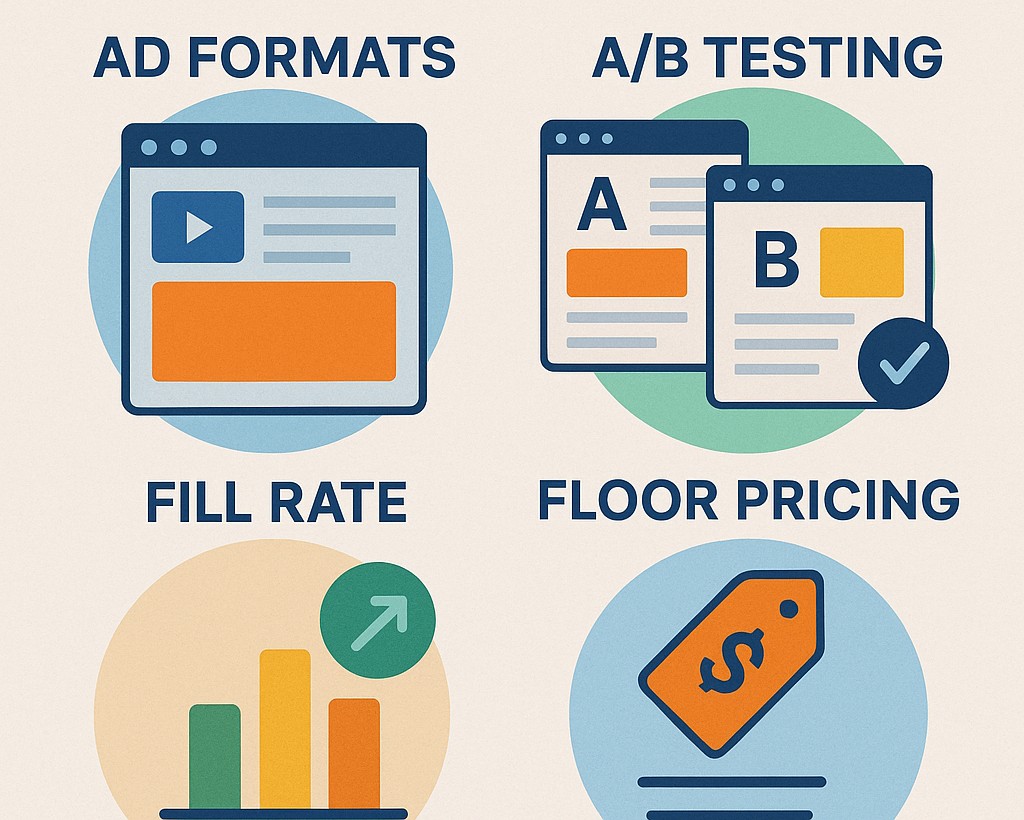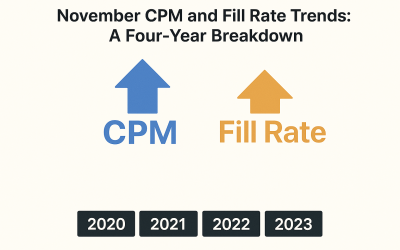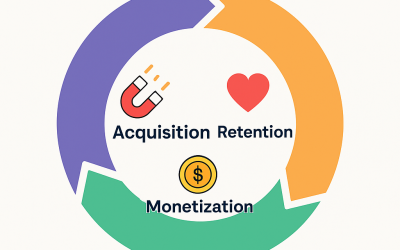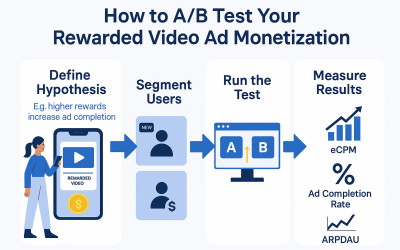The Complete eCPM Optimization Blueprint: Maximizing Your Ad Revenue Through Strategic Optimization
In the competitive landscape of digital advertising, effective Cost Per Mille (eCPM) optimization can mean the difference between a thriving monetization strategy and leaving significant revenue on the table. Whether you’re a mobile app developer, website publisher, or digital content creator, understanding how to diagnose, analyze, and optimize your eCPM is crucial for sustainable growth and profitability.
This comprehensive blueprint will guide you through proven techniques to identify low-performing areas, improve fill rates, segment your audiences effectively, and create ad experiences that maximize yield while maintaining user satisfaction.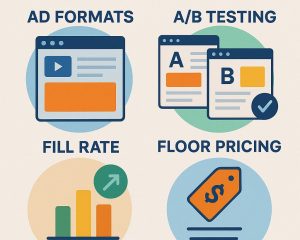
Contents
- 1 Understanding eCPM: The Foundation of Revenue Optimization
- 2 Diagnosing Low eCPM: Identifying the Root Causes
- 3 Fill Rate Optimization: Maximizing Inventory Monetization
- 4 Advanced Audience Segmentation Strategies
- 5 Ad Creative Optimization for Maximum Yield
- 6 Implementation Roadmap and Best Practices
- 7 AppLixir: Building Your Optimization Engine
Understanding eCPM: The Foundation of Revenue Optimization
Before diving into optimization strategies, it’s essential to understand what eCPM represents and why it matters. eCPM measures the estimated earnings per thousand impressions, calculated by dividing total ad revenue by total impressions, then multiplying by 1,000. Unlike traditional CPM, which represents what advertisers pay, eCPM reflects what publishers actually earn after all deductions and fees.
A strong eCPM indicates healthy monetization, but the metric alone doesn’t tell the complete story. Factors such as fill rates, user engagement, ad placement, and audience quality all contribute to overall revenue performance. Understanding these interconnected elements forms the foundation for effective optimization.
Diagnosing Low eCPM: Identifying the Root Causes
Performance Audit Framework
The first step in eCPM optimization involves conducting a comprehensive performance audit. Start by analyzing your current metrics across different dimensions: geographic regions, device types, operating systems, traffic sources, and time periods. This multi-dimensional analysis helps identify patterns and pinpoint specific areas requiring attention.
Low eCPM often stems from several common issues. Poor ad placement can significantly impact performance, particularly when ads are positioned in locations where users rarely engage or where they disrupt the user experience. Similarly, insufficient competition among advertisers for your inventory can drive down prices, especially in less competitive geographic markets or niche content categories.
Technical Diagnostics
Technical issues frequently contribute to underperforming eCPM. Slow ad loading times, rendering problems, or integration errors can reduce advertiser demand and negatively impact auction dynamics. Implement comprehensive monitoring to track ad load times, error rates, and successful ad rendering across different devices and network conditions.
Header bidding latency represents another critical technical factor. When header bidding partners timeout or fail to respond within acceptable timeframes, you lose potential high-value bids. Analyze timeout rates, bid response times, and partner performance to identify optimization opportunities.
Data Quality Assessment
Poor data quality can significantly impact eCPM performance. Inaccurate user demographics, incomplete audience segments, or missing key-value pairs prevent advertisers from properly targeting their campaigns. Conduct regular data audits to ensure audience information remains current, accurate, and comprehensive.
Bot traffic and invalid traffic sources can also depress eCPM by introducing low-quality impressions that advertisers avoid. Implement robust traffic filtering and monitoring systems to maintain inventory quality and protect advertiser confidence.
Fill Rate Optimization: Maximizing Inventory Monetization
Waterfall Optimization Strategies
Traditional waterfall setups often leave money on the table through suboptimal partner sequencing and floor price configurations. Analyze historical performance data to identify the optimal order for your demand partners, considering not just eCPM but also fill rates and response times.
Dynamic floor pricing represents a powerful technique for improving fill rates while maintaining revenue quality. Rather than setting static floors, implement dynamic pricing based on factors such as user segments, time of day, device type, and historical performance patterns. This approach ensures you’re not leaving impressions unfilled due to overly aggressive pricing while still maintaining revenue standards.
Header Bidding Enhancement
Header bidding can significantly improve fill rates by creating real-time competition among multiple demand sources. However, successful implementation requires careful partner selection and configuration optimization. Start with proven partners who demonstrate consistent bid rates and competitive pricing for your audience segments.
Optimize header bidding timeouts to balance revenue potential with user experience. While longer timeouts may capture additional bids, they can also slow page load times and negatively impact user engagement. Test different timeout configurations to find the optimal balance for your specific audience and content.
Demand Partner Diversification
Relying too heavily on a single demand source creates vulnerability and limits competition for your inventory. Diversify your demand partners across different types: exchanges, networks, and direct partnerships. This diversification helps ensure consistent fill rates even when individual partners experience performance fluctuations.
Regularly evaluate partner performance and be prepared to make adjustments. Partners who consistently underperform in terms of fill rates, eCPM, or technical reliability should be replaced or deprioritized in favor of stronger alternatives.
Advanced Audience Segmentation Strategies
Behavioral Segmentation
Effective audience segmentation begins with understanding user behavior patterns within your platform. Segment users based on engagement levels, session duration, content preferences, and interaction patterns. High-engagement users often command premium pricing from advertisers, while different behavioral segments may respond better to specific ad formats or creative approaches.
Create segments based on user lifecycle stages: new users, active users, at-risk users, and churned users requiring re-engagement. Each segment presents different monetization opportunities and may require tailored ad strategies to optimize performance.
Geographic and Demographic Optimization
Geographic segmentation remains one of the most impactful optimization techniques. Advertisers consistently pay premium rates for users in high-value markets such as North America, Western Europe, and developed Asia-Pacific regions. However, don’t overlook emerging markets where competition may be lower but fill rates could be higher.
Demographic segmentation based on age, gender, income level, and interests enables more precise targeting and higher advertiser demand. Implement robust data collection practices to build comprehensive user profiles while maintaining privacy compliance.
Custom Audience Development
Develop custom audience segments based on your unique value proposition and user base characteristics. For example, if you operate a fitness app, create segments for different workout preferences, fitness levels, or equipment availability. These custom segments often attract niche advertisers willing to pay premium rates for highly relevant audiences.
Leverage first-party data to create lookalike segments that share characteristics with your highest-value users. These segments can command higher eCPMs due to their similarity to proven high-performing audience groups.
Ad Creative Optimization for Maximum Yield
Format Testing and Optimization
Different ad formats perform better with different audience segments and content contexts. Systematically test various formats including display banners, native ads, video ads, and interactive formats to identify optimal performance combinations. Consider user experience impact alongside revenue metrics when making format decisions.
Native advertising often achieves higher engagement rates and eCPMs by blending seamlessly with content, but requires careful implementation to maintain user trust. Video advertising typically commands premium rates but may not be suitable for all audience segments or content contexts.
Creative Relevance and Personalization
Work with demand partners to ensure ad creatives align with your audience interests and platform context. Poorly matched creatives can result in lower engagement rates, reduced advertiser satisfaction, and ultimately lower eCPMs over time.
Implement dynamic creative optimization when possible, allowing ad content to adapt based on user characteristics, behavior, or context. This personalization can significantly improve performance metrics and advertiser satisfaction.
A/B Testing Framework
Establish systematic A/B testing protocols for ad placements, formats, and creative approaches. Test one variable at a time to isolate the impact of specific changes. Key metrics to monitor include eCPM, click-through rates, viewability, and user engagement with your core content.
Document testing results and maintain a knowledge base of successful optimization strategies. This historical data becomes invaluable for making informed decisions about future optimization efforts.
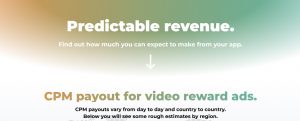 Implementation Roadmap and Best Practices
Implementation Roadmap and Best Practices
Prioritization Strategy
Begin optimization efforts with the highest-impact, lowest-effort improvements. This typically includes fixing technical issues, optimizing obvious placement problems, and implementing basic segmentation strategies. Once foundational improvements are in place, move to more sophisticated techniques requiring greater investment or technical complexity.
Focus on segments representing the largest portion of your traffic or highest revenue potential. While niche optimizations can be valuable, ensure your primary audience segments are fully optimized before addressing smaller segments.
Monitoring and Iteration
Establish regular monitoring schedules to track key performance indicators and identify emerging trends or issues. eCPM optimization requires ongoing attention rather than one-time implementation. Market conditions, advertiser demand, and user behavior patterns constantly evolve, requiring adaptive strategies.
Set up automated alerts for significant performance changes, but avoid over-reacting to short-term fluctuations. Focus on trends over multiple days or weeks rather than daily variations that may reflect normal market dynamics.
Long-term Sustainability
Successful eCPM optimization balances short-term revenue maximization with long-term user satisfaction and platform health. Avoid optimization strategies that significantly degrade user experience, as this can lead to reduced engagement, higher churn rates, and ultimately lower lifetime value.
Maintain transparent relationships with demand partners and provide them with the data and insights they need to optimize their campaigns on your inventory. Partner success directly correlates with your own revenue performance.
AppLixir: Building Your Optimization Engine
eCPM optimization represents both an art and a science, requiring technical expertise, data analysis skills, and deep understanding of user behavior and advertiser needs. The strategies outlined in this blueprint provide a comprehensive framework for systematic improvement, but success ultimately depends on consistent implementation, rigorous testing, and adaptive refinement based on performance data.
Remember that optimization is an ongoing process rather than a destination. Market conditions change, new technologies emerge, and user expectations evolve. The publishers and developers who achieve sustained success are those who commit to continuous learning, experimentation, and improvement.
By implementing these diagnostic techniques, fill rate improvements, segmentation strategies, and creative optimization approaches, you’ll build a robust foundation for maximizing ad revenue while maintaining the user experience that drives long-term growth and success.
Start with the fundamentals, measure everything, test systematically, and remain committed to the ongoing process of optimization. Your eCPM performance—and bottom line—will reflect the effort you invest in this critical aspect of digital monetization.
